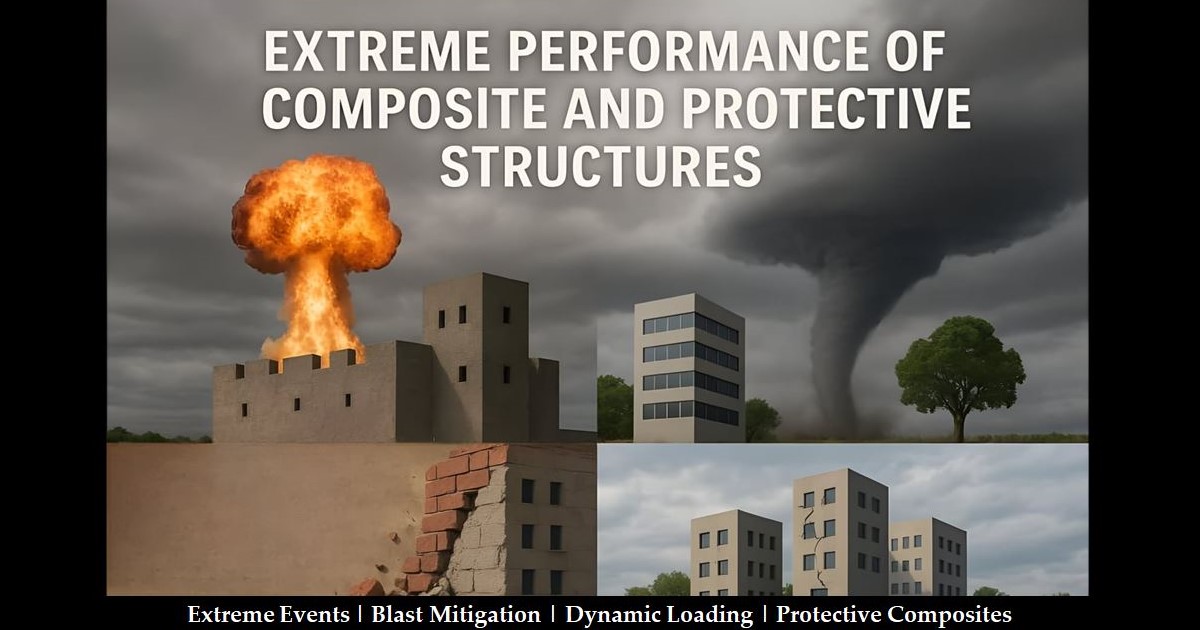Extreme Performance of Composite and Protective Structures
A special issue of Buildings (ISSN 2075-5309). This special issue belongs to the section "Building Structures".
Deadline for manuscript submissions: 28 February 2026 | Viewed by 1516

Special Issue Editors
2. Hutchison Engineering Inc., Hannibal, MO 63401, USA
Interests: structures resiliency; structural dynamics; blast mitigation; protective composites; dynamic modeling; composite structures
Interests: blast mitigation design and composite material systems; solid and structural mechanics; finite element modeling and simulation of infrastructure resilience
Special Issues, Collections and Topics in MDPI journals
Interests: structural failure analysis; frp composites; steel structures; bridges; bolted joints; numerical modeling; engineering software development.
Special Issues, Collections and Topics in MDPI journals
Interests: structures resiliency; structural dynamics; sustainable materials; concrete durability; strengthening and rehabilitation
Special Issues, Collections and Topics in MDPI journals
Special Issue Information
Dear Colleagues,
Modern structural design is increasingly focused on the ability of buildings to withstand extreme dynamic loading conditions. As we face more frequent and severe threats—ranging from blasts and explosions to high winds, wind-borne debris, hurricanes, and earthquakes—modern structures, including protective buildings, must now incorporate novel structural requirements. These requirements are essential to ensure that buildings can endure these challenges without compromising safety or functionality. This shift necessitates a deeper understanding of dynamic loading effects and the integration of innovative materials and design strategies that enhance the structural resilience of buildings against such unpredictable forces.
This Special Issue, entitled "Extreme Performance of Composite and Protective Structures", welcomes contributions that present structural analyses, propose design techniques, and address the integration of protective composites into buildings that have been engineered to confront extreme conditions. This collection targets academics, structural and construction engineers, architects, and other professionals dedicated to advancing the safety and functionality of protective buildings through innovative research and design.
We invite authors to contribute original research articles, comprehensive reviews, and insightful case studies to this Special Issue. The scope of this Special Issue includes, but is not limited to, the following topics:
- Structural dynamic approaches and numerical applications;
- Blast resistance structures;
- Impact analysis and mitigation;
- Structural performance assessment under natural hazards;
- Risk and mitigation analysis;
- Experimental methods and results;
- Numerical modeling;
- Vibration analysis and dynamic characterization;
- Shock tube testing and blast field testing.
Dr. Ahmed Elbelbisi
Prof. Dr. Hani Salim
Dr. Alaa Elsisi
Dr. Ahmed M.E. Elkilani
Dr. Mohamed Elshazli
Guest Editors
Manuscript Submission Information
Manuscripts should be submitted online at www.mdpi.com by registering and logging in to this website. Once you are registered, click here to go to the submission form. Manuscripts can be submitted until the deadline. All submissions that pass pre-check are peer-reviewed. Accepted papers will be published continuously in the journal (as soon as accepted) and will be listed together on the special issue website. Research articles, review articles as well as short communications are invited. For planned papers, a title and short abstract (about 100 words) can be sent to the Editorial Office for announcement on this website.
Submitted manuscripts should not have been published previously, nor be under consideration for publication elsewhere (except conference proceedings papers). All manuscripts are thoroughly refereed through a single-blind peer-review process. A guide for authors and other relevant information for submission of manuscripts is available on the Instructions for Authors page. Buildings is an international peer-reviewed open access semimonthly journal published by MDPI.
Please visit the Instructions for Authors page before submitting a manuscript. The Article Processing Charge (APC) for publication in this open access journal is 2600 CHF (Swiss Francs). Submitted papers should be well formatted and use good English. Authors may use MDPI's English editing service prior to publication or during author revisions.
Keywords
- structural resilience
- blast mitigation
- dynamic loading
- numerical simulation
- protective composites
- structural safety
- extreme events
- wind loads
- earthquakes
Benefits of Publishing in a Special Issue
- Ease of navigation: Grouping papers by topic helps scholars navigate broad scope journals more efficiently.
- Greater discoverability: Special Issues support the reach and impact of scientific research. Articles in Special Issues are more discoverable and cited more frequently.
- Expansion of research network: Special Issues facilitate connections among authors, fostering scientific collaborations.
- External promotion: Articles in Special Issues are often promoted through the journal's social media, increasing their visibility.
- Reprint: MDPI Books provides the opportunity to republish successful Special Issues in book format, both online and in print.
Further information on MDPI's Special Issue policies can be found here.









